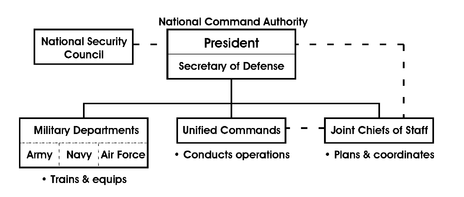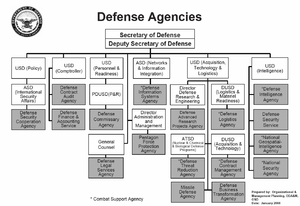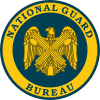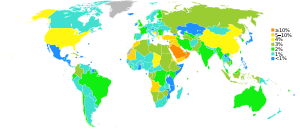- United States Department of Defense
-
Department of Defense 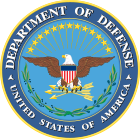
Department overview Formed August 10, 1949 Preceding Department Department of War Jurisdiction Federal government of the United States Headquarters The Pentagon,
Arlington Co., Virginia
38°52′15.56″N 77°3′21.46″W / 38.8709889°N 77.0559611°WEmployees 700,000 civilian
1,418,542 military
1,100,000 reserve [1] (2009)Annual budget US$530.1 billion (2010)[2]
US$549.1 billion (2011)[3]
US$553.0 billion (est. 2012)Department executives Leon Panetta, Secretary
Ashton Carter, Deputy SecretaryWebsite defense.gov The United States Department of Defense (Defense Department, USDOD, DOD or DoD, initially the National Military Establishment (NME)) is the U.S. federal department allocated the largest level of budgetary resources and charged with coordinating and supervising all agencies and functions of the government relating directly to national security and the United States armed forces. The organization and functions of the DoD are set forth in Title 10 of the United States Code.
The DoD is the major tenant of The Pentagon building near Washington, D.C., and has three main components: the Departments of the Army, Navy, and Air Force. Among the many DoD agencies are the Missile Defense Agency, the Defense Advanced Research Projects Agency (DARPA), the Pentagon Force Protection Agency (PFPA), the Defense Intelligence Agency (DIA), the National Geospatial-Intelligence Agency (NGA), and the National Security Agency (NSA). The department also operates several joint service schools, including the National War College.
History
 Seal of NME (1947-1949).
Seal of NME (1947-1949).
In 1945, specific plans for the proposed DoD were put forth by the Army, the Navy, and the Joint Chiefs of Staff. In a special message to Congress on 19 December 1945, President Harry Truman proposed creation of a unified department of state defense. A proposal went to Congress in April 1946, but was held up by the Naval Affairs Committee[disambiguation needed
 ] hearings in July 1946, which raised objections to the concentration of power in a single department. Truman eventually sent new legislation to Congress in February 1947, where it was debated and amended for several months.
] hearings in July 1946, which raised objections to the concentration of power in a single department. Truman eventually sent new legislation to Congress in February 1947, where it was debated and amended for several months.DoD was created in 1947 as the National Military Establishment with a single secretary as its head to preside over the former Department of War (founded in 1789) and Department of the Navy (founded in 1798; formerly the Board of Admiralty, founded in 1780). The Department of the Air Force was also created as a new service (previously under the War Department as the Army Air Forces). DoD was created in order to reduce interservice rivalry, which was believed to have reduced military effectiveness during World War II.
On July 26, 1947, Truman signed the National Security Act of 1947, which set up the "National Military Establishment" to begin operations on September 18, the day after the Senate confirmed James V. Forrestal as the first Secretary of Defense. The Establishment had the unfortunate abbreviation "NME" (with a pronunciation virtually identical to "enemy"), and was renamed the "Department of Defense" (also described in the Act under "Title II - The Department of Defense", and later abbreviated as "DoD") on August 10, 1949 -- though the new title was not without its own criticism.[4]
In addition, the Secretary of Defense was given greater authority over three of the branches of the military (Army, Navy, and Air Force). Prior to the creation of the National Military Establishment/Department of Defense, the Armed Forces of the U.S. were separated into different cabinet-level departments without much central authority. The Marine Corps remained as a separate service under the Department of the Navy, and the Coast Guard was under Department of Transportation, ready to be shifted to the Navy Department during time of declared war (as it was in both world wars).
2000s personnel expansion
To meet the growing demands in the Middle East and around the world, Secretary of Defense Robert Gates proposed to President George W. Bush to increase the overall size of the military by approximately 92,000 troops over the course of five years. Specifically, the proposal called for an Army troop cap of 550,000 active-duty soldiers and a troop cap of 202,000 active-duty Marines. The total active duty force of the U.S. after the buildup would be about 1,479,000. There are also about 1.1 million reserve troops.[5] There have also been calls to increase the sizes of the other branches of the military to match the increase in the Marines and Army.
Organization
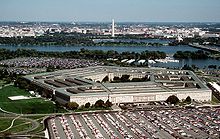 The Pentagon, headquarters of the United States Department of Defense.
The Pentagon, headquarters of the United States Department of Defense.
The Department includes the Army, Navy, Air Force, and Marine Corps, as well as non-combat agencies such as the National Security Agency and the Defense Intelligence Agency, including the NORAD base in Colorado Springs. The DoD's annual budget was roughly US$786 billion in 2007.[6] This figure does not include tens of billions more in supplemental expenditures allotted by Congress throughout the year, particularly for the war in Iraq, or expenditures by the Department of Energy on nuclear weapons design and testing.
Civilian control over matters other than operations is exercised through the three service departments, the Department of the Army, the Department of the Navy (which includes the Marine Corps), and the Department of the Air Force. Each is led by a service secretary, who is below Cabinet rank.
In wartime the Department of Defense has authority over the Coast Guard, which is under the control of the Department of Homeland Security (DHS) in peacetime. Prior to the creation of DHS, the Coast Guard was under the control of the Department of Transportation, and earlier under the Department of the Treasury. According to the U.S. Code, the Coast Guard is at all times considered one of the five armed services of the United States. During times of declared war (or by Congressional direction), the Coast Guard operates as a part of the Navy; this has not happened since World War II, but members have served in undeclared wars and conflicts since then while the service remained in its peacetime department.
The Pentagon, in Arlington County, Virginia, across the Potomac River from Washington, D.C., is the headquarters of the Department of Defense. The Department of Defense is protected by the Pentagon Force Protection Agency, which ensures law enforcement and security for the Pentagon and various other jurisdictions throughout the National Capital Region (NCR).
Chain of Command
The President of the United States is, according to the Constitution, the Commander-in-Chief of the U.S. Armed Forces and Chief Executive of the Federal Government. The Secretary of Defense is the "Principal Assistant to the President in all matters relating to the Department of Defense", and is vested with statutory authority (10 U.S.C. § 113) to lead the Department of Defense and all of its component agencies, including military command authority second only to the President.
The President and the Secretary of Defense exercise authority and control of the Armed Forces through two distinct branches of the chain of command. One branch (10 U.S.C. § 162) runs from the President, through the Secretary of Defense, to the Combatant Commanders for missions and forces assigned to their commands. The other branch, used for purposes other than operational direction of forces assigned to the combatant commands, runs from the President through the Secretary of Defense to the Secretaries of the Military Departments, i.e., the Secretary of the Army (10 U.S.C. § 3013), the Secretary of the Navy (10 U.S.C. § 5013), and the Secretary of the Air Force (10 U.S.C. § 8013). The Military Departments, organized separately within the Department of Defense, operate under the authority, direction, and control of the Secretary of that Military Department. The Secretaries of the Military Departments exercise authority through their respective Service Chiefs (i.e., Chief of Staff of the Army, Chief of Naval Operations, Commandant of the Marine Corps, and Chief of Staff of the Air Force) over forces not assigned to a Combatant Command. The Service Chiefs, except as otherwise prescribed by law, perform their duties under the authority, direction, and control of the Secretaries of their respective Military Departments, to whom they are directly responsible.
In the Goldwater-Nichols Department of Defense Reorganization Act of 1986, Congress clarified the command line to the combatant commanders and preserved civilian control of the military. The Act states that the operational chain of command runs from the President to the Secretary of Defense to the Combatant Commanders. The Act permits the President to direct that communications pass through the Chairman of the Joint Chiefs of Staff from the Secretary of Defense, and to the Combatant Commanders. This authority places the Chairman in the communications chain. Further, the Act gives the Secretary of Defense wide latitude to assign the Chairman oversight responsibilities for the activities of the Combatant Commanders.
Civilian control
Article II Section 2 of the Constitution designates the President as "Commander in Chief" of the Army, Navy and state militias.[7] The President exercises this supreme command authority through the civilian Secretary of Defense, who by federal law is the head of the department, has authority direction, and control over the Department of Defense, and is the principal assistant to the President in all matters relating to the Department of Defense.[8] The Secretary's principal deputy is the equally civilian Deputy Secretary of Defense who is delegated full powers to act for the Secretary of Defense. The Office of the Secretary of Defense (OSD) is the Secretary and Deputy Secretary's civilian staff, which includes several Under Secretaries and Assistant Secretaries of Defense with functional oversight responsibilities. The Secretaries of the Military Departments (i.e. Secretary of the Army, Secretary of the Navy, and Secretary of the Air Force) are subordinate to the Secretary of Defense. They have the authority under Title 10 of the United States Code to conduct all the affairs of their respective departments (Department of the Army, Department of the Navy, and Department of the Air Force) within which the military services are organized.[9]
Historically, there have been challenges to civilian control. Most notably, during the Korean War, General Douglas MacArthur ignored civilian instructions regarding advancing troops toward the Yalu River, which triggered an introduction of massive forces from China. Also, on April 5, 1950, Representative Joseph William Martin, Jr., the Minority Leader of the United States House of Representatives, released copies of a letter from MacArthur critical of President Harry S. Truman's limited-war strategy to the press and read it aloud on the floor of the house.[10] President Truman relieved MacArthur of command, and MacArthur then explored political options against Truman.[11] The Revolt of the Admirals is another example in the same era of a challenge to civilian control.
DoD policies and directives protect the policy of civilian control by establishing strict limitations on the political activities of members of the military. For example, DoD Directive 1344.10 prohibits active-duty members of the military from running for office or making political appearances in uniform.[12] However, enforcing this strict separation between the military and politics has been problematic. For example, over the years, many elected officials, including members of Congress, continued serving in the reserves while holding elected office. As another example, at a September 14, 2007, rally for Republican Presidential candidate John McCain in New Hampshire, seven on-duty uniformed Army personnel addressed the gathering.[13] As another example, although DOD Directive 1344.10 prohibits political appearances by active-duty military members in uniform, Virginia Governor Bob McDonnell invited a uniformed Army Staff Sergeant to stand behind him during his televised Republican response to the 2010 State of the Union Address.[14][15]
Components of the Department of Defense
Senior Leaders
- Secretary of Defense
- Deputy Secretary of Defense
- Deputy Chief Management Officer of the Department of Defense
- Immediate Office of the Deputy Secretary
- Joint Improvised Explosive Device Defeat Organization
- Executive Secretariat
- Immediate Office of the Secretary
- Deputy Secretary of Defense
Office of the Secretary of Defense
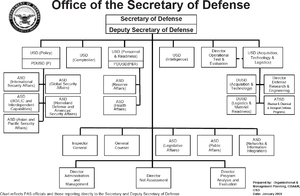 2008 Office of the Secretary of Defense Structure.
2008 Office of the Secretary of Defense Structure.
Acquisition, Technology and Logistics
- Under Secretary of Defense for Acquisition, Technology and Logistics
- Department of Defense Test Resource Management Center
- Defense Technical Information Center
- Defense Advanced Research Projects Agency
- Missile Defense Agency
- Defense Contract Management Agency
- Defense Logistics Agency
- Defense Threat Reduction Agency
- Office of Economic Adjustment
- Defense Acquisition University
- Operational Test and Evaluation Directorate (DOT&E)
Policy
Comptroller
- Under Secretary of Defense (Comptroller)/Chief Financial Officer
Personnel and Readiness
- Under Secretary of Defense for Personnel and Readiness
- Principal Deputy Under Secretary of Defense for Personnel and Readiness
- Assistant Secretary of Defense for Health Affairs
- Defense Commissary Agency
- Defense Human Resources Activity
- Uniformed Services University of the Health Sciences
- Defense Equal Opportunity Management Institute
- Office of the Chancellor for Education and Professional Development
Intelligence
- Under Secretary of Defense for Intelligence
- Assistant Secretary of Defense for Networks and Information Integration
Other OSD Offices
- Assistant Secretary of Defense for Public Affairs
- Deputy Assistant Secretary of Defense, Internal Communications
- Defense Media Activity
- Director of Administration and Management
- Director, Program Analysis and Evaluation
- General Counsel of the Department of Defense
- Defense Legal Services Agency
Defense Agencies
Defense Agencies are established as DoD Components by law, the President, or the Secretary of Defense to provide for the performance, on a DoD-wide basis, of a supply or service activity that is common to more than one Military Department when it is determined to be more effective, economical, or efficient to do so, pursuant to sections 101, 191(a), and 192 of Title 10 of the United States Code or when a responsibility or function is more appropriately assigned to a Defense Agency. Pursuant to section 191(b) Title 10, such organizations are designated as Defense Agencies. Each Defense Agency operates under the authority, direction, and control of the Secretary of Defense, through a Principal Staff Assistant in the Office of the Secretary of Defense.
Department of Defense Field Activities
Department of Defense Field Activities are established as DoD Components by law, the President, or the Secretary of Defense to provide for the performance, on a DoD-wide basis, of a supply or service activity that is common to more than one Military Department when it is determined to be more effective, economical, or efficient to do so, pursuant to sections 101, 191(a), and 192 of Title 10 of the United States Code. Pursuant to section 191(b) of Title 10, such organizations are designated as DoD Field Activities. Each DoD Field Activity operates under the authority, direction, and control of the Secretary of Defense, through a Principa Staff Assistant in the Office of the Secretary of Defense.
Military Departments
Department of the Army
The Department of the Army includes all elements of the U.S. Army
Headquarters, Department of the Army
- Office of the Secretary of the Army
- Under Secretary of the Army
- Assistant Secretary of the Army (Acquisition, Logistics, and Technology)
- Assistant Secretary of the Army (Civil Works)
- Assistant Secretary of the Army (Financial Management and Comptroller)
- Assistant Secretary of the Army (Installations, Energy and Environment)
- Assistant Secretary of the Army (Manpower and Reserve Affairs)
- General Counsel of the Army
- Administrative Assistant to the Secretary of the Army
- Inspector General of the Army
- Under Secretary of the Army
- The Army Staff
- Chief of Staff of the Army
- Vice Chief of Staff of the Army
- Sergeant Major of the Army
- Director of the Army Staff
- Judge Advocate General of the Army
- Provost Marshal General
- Chief of Staff of the Army
Army Field Organizations
(See Structure of the United States Army)
- Army Commands
- Army Component Commands
- Field Operating Agencies
- Direct Reporting Units
- United States Army Corps of Engineers
The Department of the Navy includes all elements of the U.S. Navy and the U.S. Marine Corps
- Office of the Secretary of the Navy
- Under Secretary of the Navy
- Assistant Secretary of the Navy (Financial Management and Comptroller)
- Assistant Secretary of the Navy (Installations and Environment)
- Assistant Secretary of the Navy (Manpower and Reserve Affairs)
- Assistant Secretary of the Navy (Research, Development and Acquisitions)
- General Counsel of the Navy
- Judge Advocate General of the Navy
- Naval Inspector General
- Assistant for Administration to the Secretary of the Navy
- Under Secretary of the Navy
- Office of the Chief of Naval Operations
- Headquarters Marine Corps
- Commandant of the Marine Corps
- Assistant Commandant of the Marine Corps
- Sergeant Major of the Marine Corps
- Director of the Marine Corps Staff
- Commandant of the Marine Corps
Marine Corps Field Organizations
(See Organization of the United States Marine Corps)
- Operating Forces
- Support Establishment
- Marine Forces Reserve
(See Structure of the United States Navy)
- Operating Forces
- Shore Establishment
Department of the Air Force
The Department of the Air Force includes all elements of the U.S. Air Force
Headquarters Air Force
- Office of the Secretary of the Air Force
- Under Secretary of the Air Force
- Assistant Secretary of the Air Force (Acquisition)
- Assistant Secretary of the Air Force (Financial Management & Comptroller)
- Assistant Secretary of the Air Force (Installations, Environment & Logistics)
- Assistant Secretary of the Air Force (Manpower & Reserve Affairs)
- General Counsel of the Air Force
- Administrative Assistant to the Secretary of the Air Force
- Inspector General of the Air Force
- Under Secretary of the Air Force
- The Air Staff
- Chief of Staff of the Air Force
- Vice Chief of Staff of the Air Force
- Chief Master Sergeant of the Air Force
- Assistant Vice Chief of Staff of the Air Force
- Judge Advocate General of the Air Force
- Chief of Staff of the Air Force
Air Force Field Organizations
Organization of the Joint Chiefs of Staff
- Chairman of the Joint Chiefs of Staff
- Vice Chairman of the Joint Chiefs of Staff
- Joint Chiefs of Staff
- The Joint Staff
- Director of the Joint Staff
- DOM- Directorate of Management
- J1 - Personnel and Manpower
- J2 - Intelligence
- J3 - Operations
- National Military Command Center
- Alternate National Military Command Center
- National Airborne Operations Center
- J4 - Logistics
- J5 - Strategic Plans and Policy
- J6 - Command, Control, Communications and Computer Systems
- J7 - Operational Plans and Joint Force Development
- J8 - Force Structure, Resources, and Assessment
- Director of the Joint Staff
- National Defense University
- College of International Security Affairs
- Industrial College of the Armed Forces
- Information Resources Management College
- Joint Forces Staff College
- National War College
- U.S. Delegation to the Inter-American Defense Board
- U.S. Delegation to the United Nations Military Staff Committee
- U.S. Representative at the NATO Military Committee
- U.S. Section, Joint Mexico-U.S. Defense Commission
Unified Combatant Commands
There are nine Unified Combatant Commands; six regional and three functional. United States Africa Command became initially operational in October 2007, while Joint Forces Command was officially disestablished on August 4, 2011.
Seal Name Acronym Headquarters Area of Responsibility Other Role of CCDR United States Africa Command AFRICOM Kelley Barracks, Stuttgart, Germany; to be relocated to African continent or other location TBD Africa excluding Egypt 
United States Central Command CENTCOM MacDill Air Force Base, Florida Egypt through the Persian Gulf region, into Central Asia 
United States European Command EUCOM Stuttgart, Germany Europe, including Turkey, and Israel Also Supreme Allied Commander Europe (SACEUR) 
United States Northern Command NORTHCOM Peterson Air Force Base, Colorado North American homeland defense and coordinating homeland defense with federal and state civil authorities. Also Commander of North American Aerospace Defense Command (NORAD)
(bilateral U.S.-Canadian military command)
United States Pacific Command PACOM Camp H. M. Smith, Oahu, Hawaii The Asia-Pacific region including Hawaii. 
United States Southern Command SOUTHCOM Miami, Florida South, Central America and the surrounding waters 
U.S. Special Operations Command SOCOM MacDill Air Force Base, Florida Provides special operations for the Army, Navy, Air Force and Marine Corps. 
United States Strategic Command STRATCOM Offutt Air Force Base, Nebraska Covers the strategic deterrent force and coordinates the use of space assets. 
United States Transportation Command TRANSCOM Scott Air Force Base, Illinois Covers global mobility of all military assets for all regional commands. The Geographic Commands 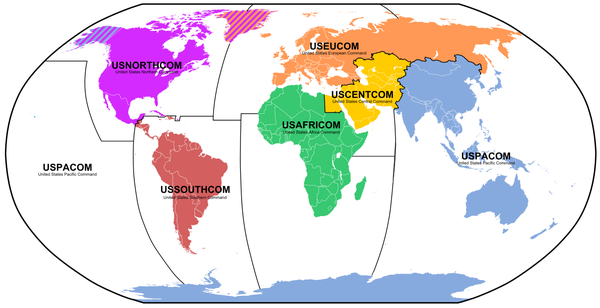
In 2007, a new geographical command for Africa was authorized. This proposed significant changes to the areas of responsibility for other adjacent geographical commands as shown in the accompanying graphic.
Office of the Inspector General of the Department of Defense
The Office of the Inspector General is an independent and objective unit within the Department of Defense that conducts and supervises audits and investigations relating to the programs and operations of the Department of Defense, pursuant to the responsibilities specified in title 5, U.S.C. Appendix and DoDD 5106.01.
National Guard Bureau
The National Guard Bureau (NGB) is a joint activity of the Department of Defense. The Chief of the National Guard Bureau is a principal advisor to the Secretary of Defense, through the Chairman of the Joint Chiefs of Staff, on matters involving non-federalized National Guard forces, and other matters as determined by the Secretary of Defense. For NGB matters pertaining to the responsibilities of the Departments of the Army and Air Force in law or DoD policy, the Secretary of Defense normally exercises authority, direction, and control over the NGB through the Secretaries of the Army and the Air Force. The NGB is the focal point at the strategic level for National Guard matters that are not under the authority, direction, and control of the Secretaries of the Army or Air Force, including joint, interagency, and intergovernmental matters where the NGB acts through other DoD officials as specified in DoDD 5105.77.
Other
The United States Naval Observatory falls under the Chief of Naval Operations. In 2003 the National Communications System was moved to the Department of Homeland Security, but only for executive purposes; it still centralizes its activities within the Department of Defense, since the human resources required by NCS (example: Military Departments) still reside within the Department of Defense, or for retention of practical maintenance.
Expenditures
Main article: Military budget of the United StatesIn the 2010 United States federal budget, entitled "A New Era of Responsibility," the DoD was allocated a base budget of $533.7 billion, with a further $75.5 billion adjustment in respect of 2009, and $130 billion for overseas contingencies.[18] The subsequent 2010 DoD Financial Report shows DoD total budgetary resources for fiscal year 2010 were $1.2 trillion.[19] Of these resources, $1.1 trillion were obligated and $994 billion were disbursed, with the remaining resources relating to multi-year modernization projects requiring additional time to procure.[19]
Budgeted DoD expenditure for 2009 represented approximately 43% of global military spending, the U.S. ranking second in terms of per capita military spending behind the United Arab Emirates.[20] In FY 2010 DoD budgeted spending accounted for 21% of the U.S. Federal Budget, and 53% of federal discretionary spending, which represents funds not accounted for by pre-existing obligations.[21]
As a percentage of its GDP, the U.S. spent 3% of GDP on military in the year 2000, ranking it 28th in the world.[22] Budgeted 2010 expenditure (including the Global War on Terror supplemental) had risen to 4.5 % of Assumed Nominal GDP.[21]
GAO audits
On February 26, 2002, the Office of the Inspector General, U.S. Department of Defense has reported that DoD has not and will not account for $1.1 trillion of "unsupported accounting entries."[23] In addition, there have been several high-profile Government Accountability Office (GAO) investigations of the Department of Defense.
The Government Accountability Office was unable to provide an audit opinion on the 2010 financial statements of the U.S. government because of "widespread material internal control weaknesses, significant uncertainties, and other limitations."[24] The GAO cited as the principal obstacle to its provision of an audit opinion "serious financial management problems at the Department of Defense that made its financial statements unauditable."[24]
In Fiscal Year (FY) 2010, six out of 33 DoD reporting entities received unqualified audit opinions.[19]
Under Secretary of Defense Robert F. Hale acknowledged enterprise-wide problems with systems and processes,[25] while the DoD's Inspector General reported "material internal control weaknesses ... that affect the safeguarding of assets, proper use of funds, and impair the prevention and identification of fraud, waste, and abuse."[26] Further management discussion in the FY 2010 DoD Financial Report states "it is not feasible to deploy a vast number of accountants to manually reconcile our books" and concludes that "although the financial statements are not auditable for FY 2010, the Department's financial managers are meeting warfighter needs."[27]
In addition to FY 2010, the Department of Defense's financial statements were either unauditable or such that no audit opinion could be expressed for FYs 2009-1998.[28][29][30][31][32][33][34][35][36][37]
Reform
In a statement of 6 January 2011 Defense Secretary Robert M. Gates stated: "This department simply cannot risk continuing down the same path - where our investment priorities, bureaucratic habits and lax attitude towards costs are increasingly divorced from the real threats of today, the growing perils of tomorrow and the nation's grim financial outlook." Gates has proposed a budget which, if approved by the Congress, would reduce the costs of many DOD programs and policies, including reports, the IT infrastructure, fuel, weapon programs, DOD bureaucracies, and personnel.[38]
The GAO is also interested in ways DoD can partner with other government agencies to save money and create efficiencies. One way was through use of the Veterans Administration's Consolidated Mail Outpatient Pharmacy (CMOP) program. The CMOP fills continuation of therapy or refill prescriptions only. Initial prescriptions are written for veterans at one of the Veteran Administration’s health care facilities. When a refill is needed, the health care facilities process the prescriptions. The CMOP then uploads this information from multiple facilities in its region. Once filled, the United States Postal Service (USPS) delivers the prescriptions. The health care facility or clinic is notified of the prescription’s completion electronically. As of 2000, the annual workload was near 50 million prescriptions. Processing and filling prescriptions took two days; three more days were required for mail delivery.
The DoD and VA conducted a pilot program in FY 2003. In its 2005 report, GAO-05-555, the GAO found that the DOD could generate savings because CMOP's size allows it to negotiate volume discounts. The CMOP program is now serving the entire country from a number of locations including West Los Angeles, California; Bedford, Massachusetts; Dallas, Texas; Hines, Illinois, Charleston, South Carolina; Leavenworth, Kansas; and Murfreesboro, Tennessee.
Energy use
DoD's Energy Conservation Investment Program (ECIP) improves the energy and water efficiency of existing Military Services' facilities. The program's projects help the Military Services save on energy usage and cost.[39] The American Recovery and Reinvestment Act of 2009 provided $120 million for the ECIP.
The American Recovery and Reinvestment Act of 2009 has also given money for the Army, Navy, Marine Corps, Air Force, Army Reserve, Navy Reserve, Marine Corps Reserve, Air Force Reserve, Army National Guard and Air National Guard facilities to invest in energy efficiency.
The Department of Defense uses 4,600,000,000 US gallons (1.7×1010 L) of fuel annually, an average of 12,600,000 US gallons (48,000,000 L) of fuel per day. A large Army division may use about 6,000 US gallons (23,000 L) per day. According to the 2005 CIA World Factbook, if it were a country, the DoD would rank 34th in the world in average daily oil use, coming in just behind Iraq and just ahead of Sweden.[40]
In FY 2006, the DoD used almost 30,000 gigawatt hours (GWH) of electricity, at a cost of almost $2.2 billion. The DoD's electricity use would supply enough electricity to power more than 2.6 million average American homes. In electricity consumption, if it were a country, the DoD would rank 58th in the world, using slightly less than Denmark and slightly more than Syria (CIA World Factbook, 2006).[41]
The DoD uses 93% of all US government fuel consumption (Air Force: 52%; Navy: 33%; Army: 7%. Other DoD: 1%).[41]
In 2010, DoD established the Office of the Assistant Secretary of Operational Energy Plans and Programs to coordinate energy issues. In July 2010, DoD also signed a Memorandum of Understanding with the U.S. Department of Energy to facilitate cooperation and accelerate research, development, and deployment of energy efficiency and renewable energy technologies.[42]
The Air Force is the largest user of fuel energy in the federal government. The Air Force uses 10% of the nation's aviation fuel. (JP-8 accounts for nearly 90% of its fuels.) This fuel usage breaks down as such: 82% jet fuel, 16% facility management and 2% ground vehicle/equipment.[43] To meet renewable energy goals, it plans to certify its entire fleet on coal-to-liquid synthetic fuel blends by 2011. By 2016, it plans to fuel half of its domestic transportation by US-produced synthetic blends, including blends of biofuels and jetfuels, known as Hydrotreated Renewable Jet (HRJ).[42] The Air Force is currently the leading purchaser of renewable energy within the Federal government and has been a long time pioneer of renewable energy development and leadership. The Air Force is recognized by the Environmental Protection Agency as a Green Power Partner, one of the nation’s top purchasers of green power.[44] The Air Force Energy Plan, published in May 2010, includes more information about the Air Force’s goals, including reducing demand, increasing supply, and changing the culture to include energy awareness.[45]
The US Army has recently prioritized renewable energy strategies in Iraq.[46] Strategies include the Tactical Garbage to Energy Refinery Program, which converts 1 short ton (0.91 t) of waste to 11 US gal (42 L) of JP-8 fuel, a photovoltaic flexible, portable mat, insulating foam technology, hybrid-electric Manned Ground Vehicles (MGV), and highly efficient portable cells.[46] The American Recovery and Reinvestment Act gave more than $150 million to develop these technologies.[46] Stateside, the Army created the Net Zero program with a goal to have 30 installations achieve net-zero energy by 2030, including some that will also be net-zero in waste and water.[42][47] In 2011, they opened the Base Camp Systems Integration Laboratory, which compares an energy efficient base camp with a traditional one and trains soldiers to use energy efficient technologies.[48] The Army Energy Security Implementation Strategy,[49] published in 2009, gives details about the Army’s energy goals.[50]
The Department of the Navy established Task Force Energy to focus on meeting energy goals, which include reducing non-tactical petroleum use in the commercial fleet by 50 percent by 2015, producing at least 50 percent of shore based energy from alternative sources by 2050, acquiring 50 percent of total energy from alternative sources by 2020, and having 50 percent of Navy and Marine Corps installations be net-zero by 2020.[42][51] The Navy hopes to demonstrate a Green Strike Group (fueled by biofuels and nuclear power) by 2012 and sail the Great Green Fleet by 2016.[42] The Office of Naval Research developed and deployed the Experimental Forward Operating Base (ExFOB), including photovoltaic energy, shelter insulation, small unit water purification, and energy efficient heating, lighting, and cooling.[52]
The Marine Corps established the Expeditionary Energy Office to increase combat effectiveness by reducing the need for liquid fossil fuel by 50 percent by 2025, using liquid fuel for mobility only.[53]
Controversies
Gulf War Illness - During 2001 and 2002, Dr. Robert F. Garry of Tulane University in New Orleans, successfully developed the Anti-Squalene Antibody blood test (ASA Assay) which can detect Gulf War Illness (US patent 6,214,566). However, soon thereafter, the rights to the patent were "Optioned" by the US Department of Defense and as of April 2011, the DOD is still sitting on the test, although still making payments to hold onto the rights. Tulane University, Dr. Garry and Autoimmune Technologies (A third-party company which apparently holds some legal right to the test) have remained silent.[54][55]
In fall of 2006, the U.S. Defense Department accidentally shipped ballistic missile components instead of helicopter batteries to Taiwan, it was reported on March 25, 2008. The parts were 1960s technology, designed for use with Minuteman ballistic missiles. The missile components were first shipped from F.E. Warren Air Force Base in Wyoming to Hill Air Force Base in Utah in 2005.[56]
On April 20, 2008, The New York Times published an exposé accusing the U.S. Department of Defense of running a propaganda "message machine" to spread the administration's talking points on Iraq by briefing retired military commanders for network television and cable television appearances, where they were presented as independent analysts.[57][58]
The Guantanamo Bay detention camp is on a United States Department of Defense base and is run by the United States Department of Defense Joint Task Force Guantanamo, with the motto 'Honour Bound to Defend Freedom'.[59] International calls for the closure of this facility due to accusations of torture perpetrated within have not been successful.[60]
Related legislation
- 1947: National Security Act of 1947
- 1958: Department of Defense Reorganization Act PL 85-899
- 1963: Department of Defense Appropriations Act PL 88-149
- 1963: Military Construction Authorization Act PL 88-174
- 1967: Supplemental Defense Appropriations Act PL 90-8
- 1984: Department of Defense Authorization Act PL 98-525
- 1986: Goldwater-Nichols Act of 1986 or Department of Defense Reorganization Act PL 99-433
- 1996: Antiterrorism and Effective Death Penalty Act PL 104-132
See also
- The Berry Amendment, a U.S.C law that requires most goods used by the armed forces to be produced domestically.
- Defense contractor
- Defense industry
- Department of Defense Police
- Director of Operations, Planning and Development for Military Commissions
- DOD Information Assurance Certification and Accreditation Program
- Exceptional Family Member Program
- Identification badges of the United States military
- List of United States military bases
- Loss of Strength Gradient
- US Senate Report on chemical weapons
References
- ^ "Department of Defense" (PDF). http://siadapp.dmdc.osd.mil/personnel/MILITARY/history/hst0909.pdf. Retrieved 2010-10-15.
- ^ "Budget of the US Government, FY 2011" (PDF). http://www.gpoaccess.gov/usbudget/fy12/pdf/BUDGET-2012-BUD-7.pdf. Retrieved 2010-10-15.
- ^ Defense.gov
- ^ Hugh W. Nibley (1944-07-04). "Warfare and the Book of Mormon". Maxwellinstitute.byu.edu. http://maxwellinstitute.byu.edu/publications/transcripts/?id=14. Retrieved 2010-10-15.
- ^ Bender, Bryan (12 January 2007). "Gates calls for buildup in troops". The Boston Globe. http://www.boston.com/news/nation/washington/articles/2007/01/12/gates_calls_for_buildup_in_troops/. Retrieved 11 November 2007
- ^ "National Defense Budget Estimates for FY 2006" (PDF). U.S. Department of Defense. April 2005. http://www.dod.mil/comptroller/defbudget/fy2006/fy2006_greenbook.pdf. Retrieved 11 November 2007.
- ^ "Caselaw: constitution article 2". http://caselaw.lp.findlaw.com/data/Constitution/article02/. Retrieved 15 April 2010.
- ^ 10 U.S.C. 113
- ^ 10 U.S.C. §§ 3013, 5013 & 8013
- ^ James 1985, pp. 584–589.
- ^ James, D. Clayton (1985). Volume 3, Triumph and Disaster 1945–1964. Boston: Houghton Mifflin. pp. 607–608. ISBN 0-395-36004-8. OCLC 36211311
- ^ "DoD Directive 1344.10, February 19, 2008 -- POSTED 2/21/2008" (PDF). http://www.dtic.mil/whs/directives/corres/pdf/134410p.pdf. Retrieved 2010-10-15.
- ^ ssenberg, Sasha (28 September 2007). "Army personnel spoke at McCain rally". Boston Globe. http://www.boston.com/news/nation/articles/2007/09/28/army_personnel_spoke_at_mccain_rally/. Retrieved 15 April 2010.
- ^ Kumar, Anita (27 January 2010). "McDonnell's guests at tonight's State of the Union response". Washington Post. http://voices.washingtonpost.com/virginiapolitics/2010/01/post_560.html. Retrieved 10 April 2010.
- ^ "Bob McDonnell's Republican Response to the SOTU: A Military Misstep". 28 January 2010. http://momocrats.typepad.com/momocrats/2010/01/dont-play-politics-with-the-military-bob-mcdonnells-republican-response-to-the-sotu.html. Retrieved 10 April 2010.
- ^ http://www.health.mil/aboutMHS.aspx
- ^ tricare.mil
- ^ "United States Federal Budget for Fiscal Year 2010 (vid. p.53)". Government Printing Office. http://www.gpoaccess.gov/usbudget/fy10/pdf/fy10-newera.pdf. Retrieved 9 January 2010.
- ^ a b c "FY 2010 DoD Agencywide Agency Financial Report (vid. p.25)". US Department of Defense. http://comptroller.defense.gov/cfs/fy2010/01_DoD_Agency-Wide/Fiscal_Year_2010_DoD_Agencywide_Agency%20Financial%20Report.pdf. Retrieved 7 January 2011.
- ^ "The SIPRI Military Expenditure Database". Stockholm International Peace Research Institute. http://milexdata.sipri.org/. Retrieved 10 January 2011.
- ^ a b "United States Federal Budget for Fiscal Year 2010". Government Printing Office. http://www.gpoaccess.gov/usbudget/fy10/pdf/fy10-newera.pdf. Retrieved 9 January 2010.
- ^ Truthandpolitics.com
- ^ Steensma, David K. (26 February 2002) (PDF). Independent Auditor's Report on the Department of Defense Fiscal Year 2001 Agency-Wide Financial Statements. DoD Inspector General. p. 2. Report No. D-2002-055. http://www.dodig.osd.mil/Audit/reports/fy02/02-055.pdf. Retrieved 11 November 2007
- ^ a b "US Government's 2010 Financial Report Shows Significant Financial Management and Fiscal Challenges". U.S. Government Accountability Office. http://www.gao.gov/press/financial_report_2010dec21.html. Retrieved 6 January 2011.
- ^ "FY 2010 DoD Agencywide Agency Financial Report (vid. p.18)". US Department of Defense. http://comptroller.defense.gov/cfs/fy2010/01_DoD_Agency-Wide/Fiscal_Year_2010_DoD_Agencywide_Agency%20Financial%20Report.pdf. Retrieved 7 January 2011.
- ^ "FY 2010 DoD Agencywide Agency Financial Report (vid. p.32)". US Department of Defense. http://comptroller.defense.gov/cfs/fy2010/01_DoD_Agency-Wide/Fiscal_Year_2010_DoD_Agencywide_Agency%20Financial%20Report.pdf. Retrieved 7 January 2011.
- ^ "FY 2010 DoD Agencywide Agency Financial Report (vid. pp. 20, 28)". US Department of Defense. http://comptroller.defense.gov/cfs/fy2010/01_DoD_Agency-Wide/Fiscal_Year_2010_DoD_Agencywide_Agency%20Financial%20Report.pdf. Retrieved 7 January 2011.
- ^ "DoD Agency Financial Report for FY 2009 (vid. p.23)". Office of the Under Secretary of Defense (Comptroller). http://comptroller.defense.gov/cfs/fy2009/01_DoD_Agency-Wide/Fiscal_Year_2009_Department_of_Defense_Agencywide_Agency_Financial_Report.pdf. Retrieved 11 January 2011.
- ^ "FY 2008 Agency Financial Report (vid. p.21)". Office of the Under Secretary of Defense (Comptroller). http://comptroller.defense.gov/cfs/fy2008/01_DoD_Agency-Wide/Fiscal_Year_2008_Department_of_Defense_Agency_Wide_Financial_%20Statements_and_Notes.pdf. Retrieved 11 January 2011.
- ^ "DoD Agency Financial Report FY 2007 (vid. p.17)". Office of the Under Secretary of Defense (Comptroller). http://comptroller.defense.gov/afr/fy2007/Entire_Document_(5.1_KB).pdf. Retrieved 11 January 2011.
- ^ "DoD Performance and Accountability Report FY 2006 (vid. p.74)". Office of the Under Secretary of Defense (Comptroller). http://comptroller.defense.gov/par/fy2006/Entire_Document_(7.8_MB).pdf. Retrieved 11 January 2011.
- ^ "DoD Performance and Accountability Report FY 2005 (vid. p.137)". Office of the Under Secretary of Defense (Comptroller). http://comptroller.defense.gov/par/fy2005/FY%2005%20DoD%20PAR_all%20.pdf. Retrieved 11 January 2011.
- ^ "FY 2004, FY 2003, FY 2002 Component Financial Statements". Office of the Under Secretary of Defense (Comptroller). http://comptroller.defense.gov/cfs/fy2004.html. Retrieved 11 January 2011.
- ^ "DoD Agency-Wide Financial Statements Audit Opinion FY 2001". Office of the Under Secretary of Defense (Comptroller). http://comptroller.defense.gov/cfs/fy2001/11_Audit-Opinion-Agency-Wide-FY2001.pdf. Retrieved 11 January 2011.
- ^ "DoD Agency-Wide Financial Statements Audit Opinion FY 2000". Office of the Under Secretary of Defense (Comptroller). http://comptroller.defense.gov/cfs/fy2000/11_Section_8_FY2000.pdf. Retrieved 11 January 2011.
- ^ "DoD Agency-Wide Financial Statements Audit Opinion FY 1999". Office of the Under Secretary of Defense (Comptroller). http://comptroller.defense.gov/cfs/fy1999/11_Part_K_Sec_8.pdf. Retrieved 11 January 2011.
- ^ "DoD Agency-Wide Financial Statements Audit Opinion FY 1998". Office of the Under Secretary of Defense (Comptroller). http://comptroller.defense.gov/cfs/fy1998/09_DoD98-Seq-I-Opinion-Section.pdf. Retrieved 11 January 2011.
- ^ "Gates Reveals Budget Efficiencies, Reinvestment Possibilities". US Department of Defense. http://www.defense.gov/news/newsarticle.aspx?id=62351. Retrieved 11 January 2011.
- ^ Whitehouse.gov
- ^ Colonel Gregory J. Lengyel, USAF, The Brookings Institution, Department of Defense Energy Strategy, August 2007, [1]
- ^ a b Colonel Gregory J. Lengyel, USAF, The Brookings Institution, Department of Defense Energy Strategy, August 2007.
- ^ a b c d e Environmental and Energy Study Institute. "DoD's Energy Efficiency and Renewable Energy Initiatives". http://www.eesi.org/dod_eere_factsheet_072711. Retrieved 2011-08-02.
- ^ Powering America’s Defense: Energy and the Risks to National Security, CNA Analysis & Solutions, May 2009
- ^ "Air Force leads the way as Green Power Partner". U.S. Air Force. http://www.af.mil/news/story.asp?id=123244277. Retrieved 2011-08-02.
- ^ "Air Force Energy Plan". U.S. Air Force. http://www.safie.hq.af.mil/shared/media/document/AFD-091208-027.pdf. Retrieved 2011-08-02.
- ^ a b c Vogel, Steve. Pentagon Prioritizes Pursuit Of Alternative Fuel Sources, The Washington Post, 4/13/09
- ^ "Army Vision for Net Zero". U.S. Army. http://www.asaie.army.mil/Public/IE/doc/Net%20Zero%20White%20Paper%2014%20Dec%202010%20with%20graphics%20test%20%28Revised%29%202.pdf. Retrieved 2011-08-02.
- ^ "Base Camp Integration Lab opens at Fort Devens". U.S. Army. http://www.army.mil/article/60473/Base_Camp_Integration_Lab_opens_at_Fort_Devens/. Retrieved 2011-08-02.
- ^ http://www.asaie.army.mil/Public/Partnerships/doc/AESIS_13JAN09_Approved%204-03-09.pdf
- ^ "Army Energy Security Implementation Strategy". U.S. Army. http://www.asaie.army.mil/Public/Partnerships/doc/AESIS_13JAN09_Approved%204-03-09.pdf. Retrieved 2011-08-02.
- ^ "ONR Experimental Forward Operating Base". Office of Naval Research. http://www.onr.navy.mil/~/media/Files/Fact%20Sheets/Experimental-Forward-Operating-Base.ashx. Retrieved 2011-08-03.
- ^ "USMC Expeditionary Energy Office". U.S. Marine Corps. http://www.marines.mil/community/Documents/E2O%20Office%20Overview%20PDF.pdf.
- ^ http://www.autoimmune.com/GWSGen.html
- ^ http://tulane.edu/news/releases/archive/2000/antibodies_found_in_sick_soldiers.cfm
- ^ U.S. says missile parts mistakenly sent to Taiwan. CNN. 25 March 2008. http://edition.cnn.com/2008/US/03/25/taiwan.missiles/index.html. Retrieved 25 March 2008
- ^ Barstow, David (20 April 2008). "Message Machine: Behind Analysts, the Pentagon’s Hidden Hand". New York Times. http://www.nytimes.com/2008/04/20/washington/20generals.html?ref=todayspaper.
- ^ Sessions, David (20 April 2008). "Onward T.V. Soldiers: The New York Times exposes a multi-armed Pentagon message machine". Slate. http://www.slate.com/id/2189545/.
- ^ Levin, Angela (4 May 2008). "Greetings from Guantanamo Bay ... and the sickest souvenir shop in the world". Daily Mail (London). http://www.dailymail.co.uk/news/article-563791/Greetings-Guantanamo-Bay---sickest-souvenir-shop-world.html#ixzz1CAhHOtLq. Retrieved 26 January 2011.
- ^ Norton-Taylor, Richard; Goldenberg, Suzanne (17 February 2006). "Judge's anger at US torture". The Guardian (London). http://www.guardian.co.uk/uk/2006/feb/17/politics.world. Retrieved 26 January 2011.
External links
- United States Department of Defense Official website
- Office of the Under Secretary of Defense (Comptroller) Budget and Financial Management Policy
- Read Congressional Research Service (CRS) Reports regarding the Department of Defense
- Entire Collection of DoD Freedom of Information Act (FOIA) Reading Room
- Budget info
- Death and Taxes: 2009 A visual guide and infographic of the 2009 United States federal budget including the Department of Defense with data provided by the Comptrollers office.
- DoD YouTube channel
- Proposed and finalized federal regulations from the United States Department of Defense
- DoD IA Policy Chart
- U.S. Reporting Agency
- U.S. Reporting Agency Groundsquad Homepage
- Defense Logistics Agency
- United States Department of Defense at WhoRunsGov at The Washington Post
Agencies under the United States Department of Defense Deputy Secretary of Defense 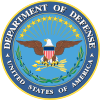
Under Secretary of Defense
for Acquisition, Technology and LogisticsDirector, Defense Research and Engineering · Defense Advanced Research Projects Agency · Missile Defense Agency · Defense Contract Management Agency · Defense Logistics Agency · Defense Technical Information Center · Defense Threat Reduction Agency · Office of Economic Adjustment · Defense Acquisition University · Business Transformation AgencyUnder Secretary of Defense for Policy Under Secretary of Defense (Comptroller) Under Secretary of Defense
for Personnel and ReadinessDefense Commissary Agency · Department of Defense Education Activity · DoD Human Resources Activity · Military Health System · Uniformed Services University of the Health Sciences · Defense Equal Opportunity Management Institute · Office of the Chancellor for Education and Professional DevelopmentUnder Secretary of Defense
for IntelligenceService Departments United States federal executive departments Agriculture • Commerce • Defense • Education • Energy • Health and Human Services • Homeland Security • Housing and Urban Development • Interior • Justice • Labor • State • Transportation • Treasury • Veterans Affairs
Categories:- United States Department of Defense
- Military-industrial complex
- Nuclear weapons infrastructure of the United States
- Ministries established in 1947
- 1947 establishments in the United States
- Secretary of Defense
Wikimedia Foundation. 2010.

